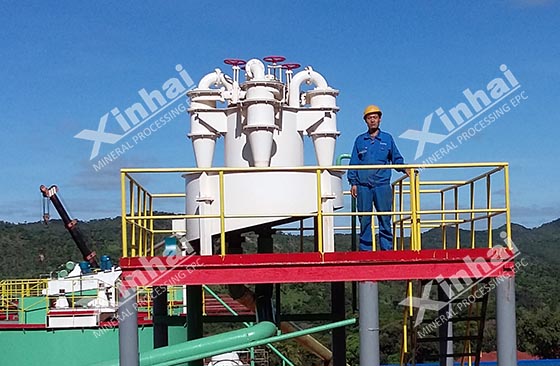

Warm Tip: If you want to know more details about equipment, solutions, etc, please click the button below for free consultation, or leave your requirements!
Hydrocyclone is a kind of equipment for classification or separation according to different particle size and density. What should you pay attention to if you want to get a good classification effect when using hydrocyclones in mineral processing plants?

When choosing a hydrocyclone, you should determine the structural parameters mainly based on the slurry volume to be processed and overflow particle size. First, you should determine the diameter of the hydrocyclone according to the slurry volume to be processed and overflow particle size. Generally, when the overflow is coarse and the processing capacity is large, it is recommended to use the large-size hydrocyclone. Otherwise, use the small-size hydrocyclone. When the processing capacity is large and the overflow is very fine, it is recommended to use small-size hydrocyclones to form a cyclone unit in parallel. Then, when the hydrocyclone diameter has been determined, you can determine other structural parameters according to the processing capacity and overflow particle size, such as the diameter of the overflow pipe, the diameter of the grit, the diameter of the ore feed, the height of the cylinder, the insertion depth of the overflow pipe, the cone angle, etc.
In general, the feeding methods of hydrocyclone mainly include the following three types:
Feeding by the height difference. This kind of feeding method requires a large height difference (generally above 5m), which is difficult to achieve when the terrain conditions do not allow.
Feeding by pressure stabilizing box. The advantage of this feeding method is that the feeding pressure is stable. But the disadvantage is that there are more pipelines, large pulp flow and poor economic effect.
Feeding by slurry pump. This feeding method has fewer pipelines and better economic effect, but the feeding pressure fluctuates greatly. At present, most mineral processing plants use slurry pumps to feed directly (that is so-called feeding by dynamic pressure).
Generally, the feeding pressure of the hydrocyclone will directly affect the processing capacity and the classification particle size, which can be adjusted by adding a frequency converter to the slurry pump. The greater the feed pressure, the higher the slurry flow rate, and the greater the processing capacity of the hydrocyclone, and the greater the rotation speed and centrifugal force of the slurry in the hydrocyclone, the finer the classification particle size. After determining the classification particle size, a certain feeding pressure is required to adapt to it. If the feeding pressure is too high, more fine particles will be mixed into the sand setting. If the feeding pressure is too low, more coarse particles will be mixed in the overflow. These will greatly reduce the classification efficiency of the hydrocyclone.
When the diameter of the output increases, the amount of grit increases, the concentration decreases, the fine particles in the grit increase, the overflow decreases and the overflow becomes finer. Conversely, when the diameter of the output decreases, the concentration of grit increases, the coarse particles in the overflow increase, and the overflow increases.
The change of the grit port diameter can be judged according to the spray angle when the grit is sprayed .And the spray angle is generally between 20°-30°. If the grit is discharged in a rope shape, it means that the grit port is small and the grit concentration is high. If the grit is discharged in an umbrella shape, it means that the grit port is large and the grit concentration is the lowest at this time.
The concentration of the feeding will directly affect the concentration and particle size of the final product. When the feed concentration is too low, the classification efficiency of the hydrocyclone will increase, but the processing capacity will decrease. When the feed concentration is too high, the viscosity of the slurry will increase, and the classification efficiency of the hydrocyclone will decrease. Generally, the finer the classification particle size, the lower the feed concentration should be.
For hydrocyclones with small diameter, cleaning are particularly important. Before feeding the slurry to the hydrocyclone, you can use a screen to separate the grass, sawdust and other debris to prevent the hydrocyclone from blocking. Generally, the slag removal screen mesh is about 1/6-1/5 of the grit port diameter.
The above introduced 6 aspects to improve the efficiency of hydrocyclone. At present, hydrocyclones have been widely used in many mineral beneficiation processes. It can not only be used as classification equipment in the grinding circuit (especially for fine grinding), but also can be used for desliming and concentration of pulp. This requires the hydrocyclone operator to be familiar with its various technical parameters, and can make corresponding adjustments according to production changes at any time to ensure the classification efficiency of the hydrocyclone.
If you have other questions about the above content, or want to buy hydrocyclone, you can consult the online customer service or submit a message, we will contact you as soon as possible!
Last: Caving Mining Method Classification and Characteristics
16 Factors Affecting Hydrocyclone Efficiency
 0
0
 4931
4931
2How to Improve Your Hydrocyclone Efficiency?
 0
0
 3922
3922
34 Types of Hydrocyclone Used in the Mineral Processing

 4243
4243


What Are the Differences Between CIP and CIL?
 11304
11304
 0
0